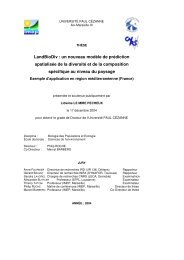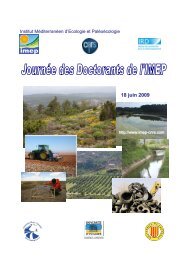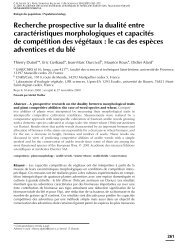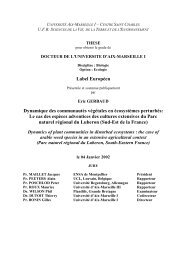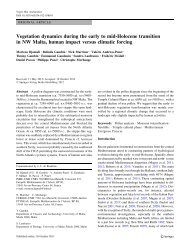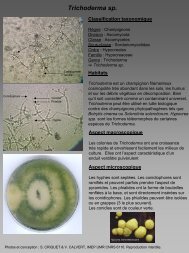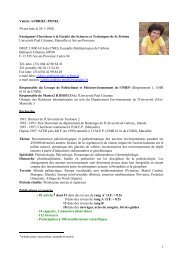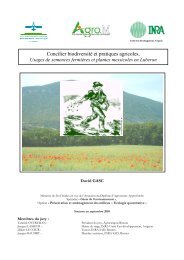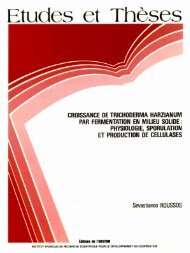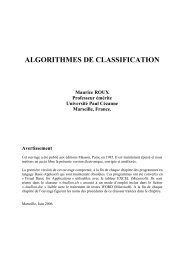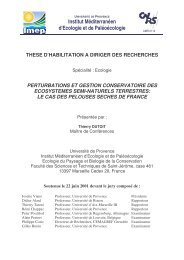UNIVERSITÉ PAUL CÉZANNE, AIX MARSEILLE III - IMEP
UNIVERSITÉ PAUL CÉZANNE, AIX MARSEILLE III - IMEP
UNIVERSITÉ PAUL CÉZANNE, AIX MARSEILLE III - IMEP
Create successful ePaper yourself
Turn your PDF publications into a flip-book with our unique Google optimized e-Paper software.
Résultats et discussion. Chapitre 3: Evaluation des facteurs de croissance<br />
cultivation. Moyson and Verachtert (1991) have demonstrated that the growth of L.edodes is<br />
initially associated to hemicellulose content of substrate, since hemicellulose and other water-<br />
soluble sugars are mainly utilized during the active growth phase, prior to the breakdown of<br />
lignin and cellulose. On the other hand, the use of OC supplemented with OMW caused in the<br />
oxygen (O2) depletion could be the cause which reduces mycelial biomass development in<br />
substrates (Ohga, 1990). Small air spaces present in OC supplemented may slow gas<br />
exchange from deep within the interior of the substrate to the surface (Royse and Sanchez-<br />
Vazquez 2001).<br />
In many cases, different factorial designs were used in the literature for assessing the<br />
effect of environmental factor on biological responses (Ranz and Lankmayr 2006; Swalley et<br />
al., 2006; Purama and Goyal 2008). The factorial design and statistical analysis were<br />
performed with NemrodW software (Mathieu and Phan-Tan-Luu, 2000). The combination of<br />
moisture content, which was maintained at 50% (v/v) with the incubation of substrate in oven<br />
for two days without forced aeration, allowed preventing any contamination of L. edodes<br />
culture with filamentous fungi which are known as major antagonistic agent in mushroom<br />
culturing (Savoie and Mata, 1999; Terashima et al., 2002; Kalmis and Sargin 2004). The<br />
supply of culture with humidified air allowed gradual increase of the substrate moisture<br />
contentand keeping the substrate with suitable moisture content.<br />
The influence of the composition of the substrate on mushroom production characters<br />
has been emphasized in recent studies (Philippoussis et al., 2001; Sunchez and Royse 2001;<br />
Philippoussis et al., 2003). In the framework of the present study, the nutriment added to the<br />
substrate and the spawn size were the main parameter that affected the growth of L. edodes.<br />
This can be attributed to the nitrogen content, imported with addition of the mineral solution,<br />
which exercised a negative effect on mycelial growth. Indeed, Nitrogen has been recognized<br />
as a growth limiting factor for the L. edodes cultivation (Boyle 1998; Kalberer 2000), while<br />
recently a positive correlation of mycelial growth to low C/N ratio values of substrates used<br />
for the cultivation has been demonstrated as well (Philippoussis et al., 2003; 2007). However,<br />
in L. edodes cultivation on synthetic composite media (OTL + OC + OMW), supplementary<br />
nutritive solution should not be used. Otherwise, when the nutritive solution was added, we<br />
observed that the risk of contamination of the growth media was increased considerably.<br />
Similar findings were reported by Schunemann (1988).<br />
The data obtained on polyphenol removal from the substrate by the culture of<br />
L. edodes, showed that there was a negative effect of mineral solution added to initial<br />
104



